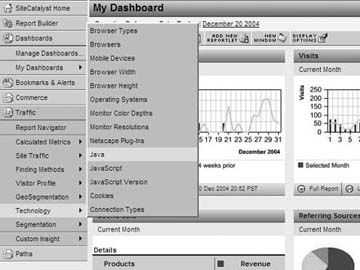Hack 74. Know Which Technographic Data to Ignore  
Not all technical data is as useful as it looks at first glance. Knowing what to pay attention to and what to ignore can save you time and prevent frustration. As you've certainly surmised by now in reading this book, web measurement applications provide a wealth of information about your visitors, most of it good! While the vendors certainly mean well, often they provide information because they cannot because there is a great business reason for doing so. Unfortunately, not all the available information is useful, especially when you're talking about technographic reports (Figure 5-13). Since most vendors provide the same technographic data, it is worth reviewing which of this information you should use and which you should ignore. 5.8.1. Technographic Data to Use The following are technographic data points and reports that are generally useful to web data analysts.
Browser type -
Your web developers and quality assurance group will benefit from a complete list of visitor browser types. Use recent (last 90 days) samples to ensure QA efforts map well to current browser trends.
Browser width -
A central concern for web developers is how much screen real estate to use, and the schism between 800 x 600 and 1024 x 768 screen resolutions. Keep a close eye on how these numbers evolve; looking for the opportunity to use more screen real estate [Hack #70] will help you make more effective design decisions. Figure 5-13. Representative sample of technographic data 
Cookies -
The cookies report provides a partial glimpse into the accuracy [Hack #15] of your data if you're using a page tag or augmenting your web server logfiles with a cookie. While not the final word on cookie acceptance by your visitors, I recommend checking this report on a monthly basis to look for any large decreases in cookie acceptance.
Connection type -
While this report is almost always built from an obscure setting available via the JavaScript DOM for Internet Explorer users, as long as your IE browser share is high, this report can help you understand whether most of your visitors are broadband or modem users, helping you refine your page design and development strategy. 5.8.2. Technographic Data to Ignore The following are technographic data points and elements that are unlikely to provide valuable insight into your visitors, either because they're too granular, not granular enough, or because they're otherwise useless.
Browsers -
While the specifics of browser type are useful from a development standpoint, watching the browser wars play out is interesting, but not useful.
Browser height -
Simply put, if you do a good job presenting content, your visitors will scroll. Alternatively, the "fold" (bottom-most point in a browser's initial load without any scrolling) is well-defined by the browser's width using a standard calculation.
Monitor color depth -
You should build well-designed web pages that use web-friendly colors.
Monitor resolutions -
The screen width report provides relevant and useful information.
Netscape plug-ins -
Depending on the breakdown of browser versions at your web site, it is very likely that this report will not paint a useful picture of plug-in usage [Hack #73] on the part of your visitors. I recommend avoiding all but the most standard plug-ins (Adobe PDF, RealPlayer, Windows Media Player, Macromedia Flash) and always building to the last version released (when relevant).
Java -
Unless you do something particularly complex on your web site, you should avoid using Java. If you need Java, know that over 90 percent of Internet users have Java enabled and use it carefully.
JavaScript -
Same as Java, but over 95 percent of Internet users allow JavaScript to run in their browsers. 5.8.3. Technographic Data that Depends on Your Specific Needs As you might expect, some data points are either useful or not, depending on your particular needs at the time. The following data points are classified in an "it depends" category and are worth understanding, just in case.
Mobile devices -
If you're actively working to provide content to mobile users, use this report the same way you would the browser types report. If you're not concerned about mobile users, ignore.
Operating systems -
Since you'll be able to get the important information about which browsers are being used by OS from the browser version report, you may be able to ignore operating systems. However, if you develop downloadable applications, you should use this report to make sure you're providing for less-popular operating systems.
JavaScript versions -
Since over 95 percent of Internet users allow JavaScript 1.3, unless a new version of JavaScript is released, this report is only nominally useful. If a new version of JavaScript is released, you should still consider building only for Version 1.3 until 90 percent of the Internet supports the new version. In general, technographic metrics are for web design and development teams and have little direct impact on your overall business success. |
